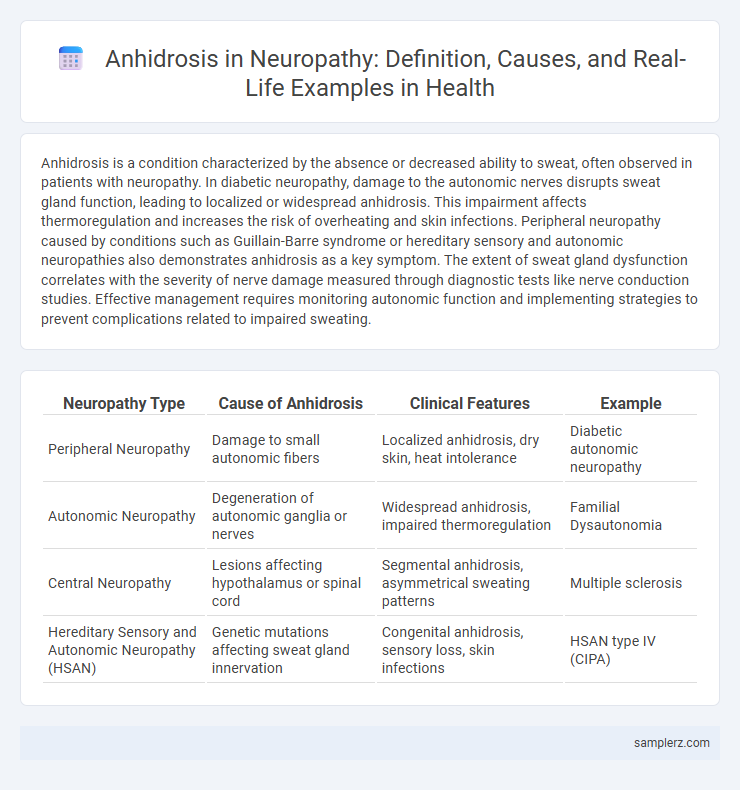Anhidrosis is a condition characterized by the absence or decreased ability to sweat, often observed in patients with neuropathy. In diabetic neuropathy, damage to the autonomic nerves disrupts sweat gland function, leading to localized or widespread anhidrosis. This impairment affects thermoregulation and increases the risk of overheating and skin infections. Peripheral neuropathy caused by conditions such as Guillain-Barre syndrome or hereditary sensory and autonomic neuropathies also demonstrates anhidrosis as a key symptom. The extent of sweat gland dysfunction correlates with the severity of nerve damage measured through diagnostic tests like nerve conduction studies. Effective management requires monitoring autonomic function and implementing strategies to prevent complications related to impaired sweating.
Table of Comparison
| Neuropathy Type | Cause of Anhidrosis | Clinical Features | Example |
|---|---|---|---|
| Peripheral Neuropathy | Damage to small autonomic fibers | Localized anhidrosis, dry skin, heat intolerance | Diabetic autonomic neuropathy |
| Autonomic Neuropathy | Degeneration of autonomic ganglia or nerves | Widespread anhidrosis, impaired thermoregulation | Familial Dysautonomia |
| Central Neuropathy | Lesions affecting hypothalamus or spinal cord | Segmental anhidrosis, asymmetrical sweating patterns | Multiple sclerosis |
| Hereditary Sensory and Autonomic Neuropathy (HSAN) | Genetic mutations affecting sweat gland innervation | Congenital anhidrosis, sensory loss, skin infections | HSAN type IV (CIPA) |
Understanding Anhidrosis: Definition and Overview
Anhidrosis, characterized by the absence or significant reduction of sweating, often occurs in neuropathy due to damage to the autonomic nerves controlling sweat glands. This condition impairs the body's ability to regulate temperature, increasing the risk of heat intolerance and heat-related illnesses. Understanding anhidrosis involves recognizing its connection to peripheral neuropathy and the vital role of sweat gland function in maintaining homeostasis.
Neuropathy as a Cause of Anhidrosis
Neuropathy as a cause of anhidrosis disrupts the autonomic nerves responsible for sweat gland function, leading to reduced or absent sweating in affected areas. Peripheral neuropathy, often seen in diabetes mellitus, damages small nerve fibers and impairs thermoregulatory sweating, resulting in localized or generalized anhidrosis. Accurate diagnosis involves clinical assessment and nerve conduction studies to identify the extent of autonomic nerve damage contributing to anhidrosis.
Common Symptoms of Anhidrosis in Neuropathy Patients
Common symptoms of anhidrosis in neuropathy patients include the inability to sweat normally, leading to overheating and heat intolerance. Patients often experience dry, cracked skin due to impaired sweat gland function and increased risk of heat-related illnesses. Other signs include localized or widespread absence of sweating, which may be accompanied by numbness or tingling in affected areas.
Types of Neuropathy Linked to Impaired Sweating
Autonomic neuropathy often leads to anhidrosis by damaging nerves that regulate sweat gland function, particularly in diabetic neuropathy where peripheral nerve fibers deteriorate. Small fiber neuropathy also impairs sweating due to its specific effect on unmyelinated C fibers responsible for autonomic control. In hereditary sensory autonomic neuropathy, genetic defects disrupt normal sweat production, resulting in widespread anhidrosis and increased risk of heat intolerance.
Case Example: Diabetic Neuropathy and Anhidrosis
Diabetic neuropathy frequently causes anhidrosis due to autonomic nerve damage impairing sweat gland function, leading to localized or widespread inability to sweat. Patients with diabetic neuropathy often experience dry, cracked skin and heat intolerance as a result of this diminished sweating response. Early recognition of anhidrosis in diabetic neuropathy is critical for preventing complications such as skin infections and heat-related illnesses.
Clinical Presentation: How Anhidrosis Manifests in Neuropathy
In neuropathy, anhidrosis manifests as a reduced or absent sweating response, typically localized to the areas served by the affected nerves, which can lead to dry, flaky skin and impaired thermoregulation. Patients often report heat intolerance, and the lack of sweating increases the risk of hyperthermia during physical exertion or in hot environments. Clinical evaluation reveals diminished sudomotor function, often confirmed by quantitative sudomotor axon reflex testing or thermoregulatory sweat tests.
Diagnostic Approaches for Anhidrosis in Neuropathic Disorders
Diagnostic approaches for anhidrosis in neuropathic disorders include quantitative sudomotor axon reflex testing (QSART) to measure sweat output and thermoregulatory sweat tests (TST) to evaluate whole-body sweating patterns. Skin biopsy with immunohistochemical staining for nerve fiber density provides insight into small fiber neuropathy contributing to anhidrosis. Autonomic reflex screening and quantitative sudomotor axon reflex tests are essential for identifying the extent and distribution of sudomotor dysfunction in neuropathic conditions.
Complications Arising from Anhidrosis in Neuropathy
Anhidrosis in neuropathy often leads to significant complications such as hyperthermia and heat intolerance due to impaired sweating mechanisms disrupting thermoregulation. Patients with diabetic neuropathy experiencing anhidrosis face increased risks of developing skin infections and ulcerations secondary to dry, cracked skin. These complications highlight the importance of early diagnosis and targeted management strategies to prevent severe morbidity in neuropathic patients.
Management and Treatment Options for Anhidrosis
Management of anhidrosis in neuropathy involves addressing the underlying nerve damage and preventing complications such as heat intolerance and skin infections. Treatment options include using topical agents like emollients to maintain skin hydration, activating alternative thermoregulation strategies, and in some cases, pharmacological interventions such as cholinergic agents to stimulate sweating. Regular monitoring and patient education on avoiding overheating are essential components of effective anhidrosis management.
Preventive Strategies and Patient Education for Anhidrosis in Neuropathy
Effective preventive strategies for anhidrosis in neuropathy include regular skin hydration, avoiding excessive heat exposure, and monitoring for early signs of skin dryness or infection. Patient education should emphasize the importance of maintaining optimal skin care routines, recognizing symptoms of impaired sweating, and seeking prompt medical evaluation to prevent complications such as hyperthermia or skin breakdown. Tailored guidance on lifestyle modifications and appropriate use of moisturizing agents significantly reduces risks associated with sweat gland dysfunction in neuropathic conditions.

example of anhidrosis in neuropathy Infographic
 samplerz.com
samplerz.com